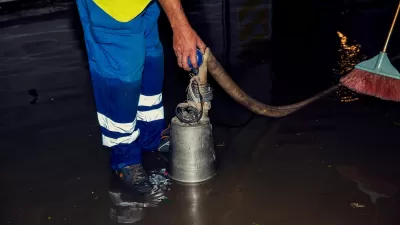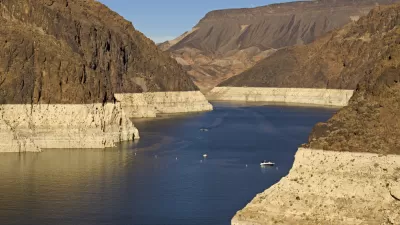The city of San Jose and designers from the University of California, Davis have completed a community-led design process to raise awareness about the connections between the kitchen, sewers, and the environment.

Faith Kearns reports on a new method for informing the public about the effects of FOG waste (the fats, oils, and greases that people can flush down sinks and toilets that lead to troubles in the sewer and beyond).
Public art might be one of the last things people associate with sewer and wastewater infrastructure, but that's the approach chosen by Claire Napawan, a landscape architect and urban designer in the Department of Human Ecology at UC Davis, and Brett Snyder, an architect and graphic designer in the Department of Design at UC Davis.
The duo worked with the city of San Jose, "as part of a unique collaboration between the city's environmental service and transportation departments, as well as its Public Art Program." Kearns details the approach to the ideas and approach behind the community engagement process before revealing the product of the project: a "suite of materials that connected household kitchen waste with sewer infrastructure."
The materials included flashcards that provide reminders of the kinds of kitchen waste that contribute to the FOG problem, marked manhole covers on city streets, and related graphics on wastewater trucks. Together, the trio of bright green and integrated graphics served as a reminder of the connection between individual kitchens, city infrastructure, and the larger ecosystem of the San Francisco Bay Area.
The hope is that the lessons gained in the community engagement process, as well as the final design product, could provide an example for other municipalities.
FULL STORY: Making the invisible visible: Connecting home water use & city infrastructure through participatory design

Alabama: Trump Terminates Settlements for Black Communities Harmed By Raw Sewage
Trump deemed the landmark civil rights agreement “illegal DEI and environmental justice policy.”

Study: Maui’s Plan to Convert Vacation Rentals to Long-Term Housing Could Cause Nearly $1 Billion Economic Loss
The plan would reduce visitor accommodation by 25% resulting in 1,900 jobs lost.

Planetizen Federal Action Tracker
A weekly monitor of how Trump’s orders and actions are impacting planners and planning in America.

Waymo Gets Permission to Map SF’s Market Street
If allowed to operate on the traffic-restricted street, Waymo’s autonomous taxis would have a leg up over ride-hailing competitors — and counter the city’s efforts to grow bike and pedestrian on the thoroughfare.

Parklet Symposium Highlights the Success of Shared Spaces
Parklets got a boost during the Covid-19 pandemic, when the concept was translated to outdoor dining programs that offered restaurants a lifeline during the shutdown.

Federal Homelessness Agency Places Entire Staff on Leave
The U.S. Interagency Council on Homelessness is the only federal agency dedicated to preventing and ending homelessness.
Urban Design for Planners 1: Software Tools
This six-course series explores essential urban design concepts using open source software and equips planners with the tools they need to participate fully in the urban design process.
Planning for Universal Design
Learn the tools for implementing Universal Design in planning regulations.
Caltrans
Smith Gee Studio
Institute for Housing and Urban Development Studies (IHS)
City of Grandview
Harvard GSD Executive Education
Toledo-Lucas County Plan Commissions
Salt Lake City
NYU Wagner Graduate School of Public Service





























